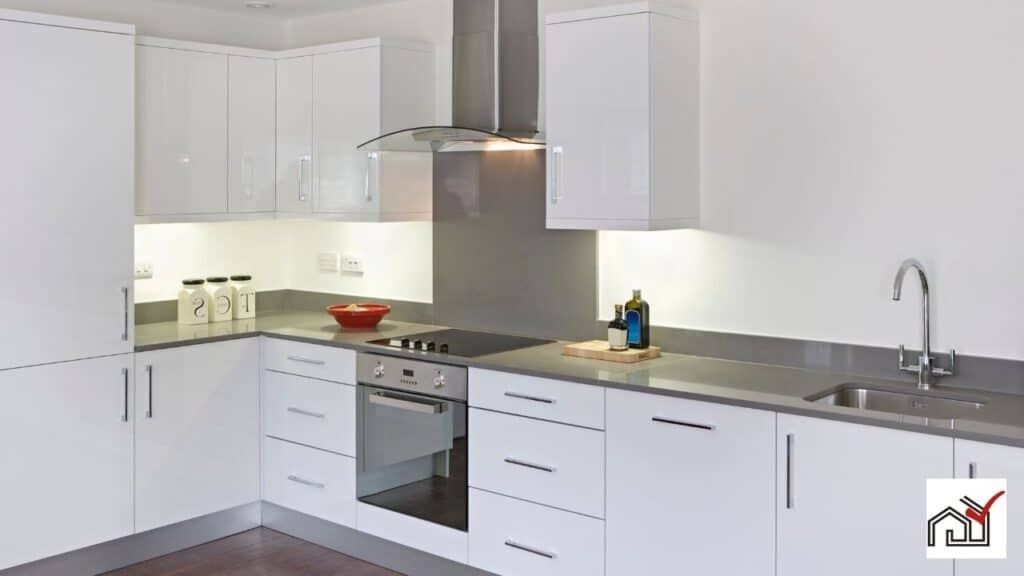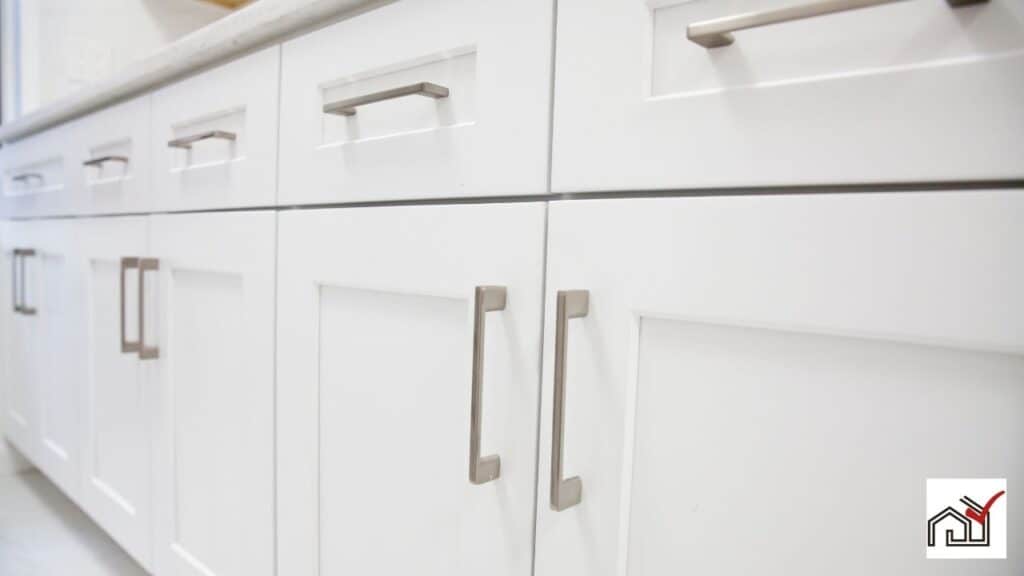A white kitchen is a classic way to brighten up the space and reflect a clean ambiance, but only as long as it retains its original luster.
So, do white kitchen cabinets turn yellow?
White Kitchen Cabinets Turning Yellow
Yes, white kitchen cabinets often turn yellow for several reasons. It could be grease accumulating on top, ruined finish coats, or aging paint. In some cases, the surrounding walls and lighting can also make the cabinets look pale in comparison.
In this post, we’ll go over all the possible causes for yellow kitchen cabinets and how to tackle them. Let’s jump right in!
Why Do White Kitchen Cabinets Turn Yellow?
To prevent (or fix) discoloration of white cabinets, you have to narrow down the causes first.
Some will be a breeze to deal with, while the others will require more drastic solutions.
So, let’s take a closer look at six common culprits behind white kitchen cabinets turning yellow.
1. Grease Residue Stains The Cabinets
Perhaps one of the most obvious reasons why an old white kitchen cabinet looks yellowish is grease, and there’s nothing more than that in a kitchen!
It doesn’t even have to be a visible oil splatter on the cabinet.
Every time you smell the food cooking, that’s air carrying tiny particles around.
Just that loaded air coming from a boiling pot or the smoke from a pan alone is enough to deposit grease over time.
This issue is plausible with almost every white cabinet material out there, but thankfully, it’s not impossible to fix or prevent.
The Fix
Make a habit of wiping your cabinet doors with a clean cloth dipped in warm water and diluted vinegar once or twice every week.
This way, you’ll stay on top of the grease before it even starts to accumulate.
Whenever you’re using the stovetop, try to get an exhaust fan or ventilation hood.
It’ll help suck up the cooking fumes before they land on white surfaces.
2. Harsh Cleaning Products Ruin The Finish
Cleaning up your kitchen is vital to keep that fresh white aesthetic alive, but some people take it a notch overboard.
Using harsh chemicals will often lead to stripping the finish coat leaving discoloration behind, and it could even ruin the wood itself.
Sure, a bit of bleach or ammonia can remove accumulated grease in a blink, but you might be taking a risk here.
Some painted cabinets will handle diluted solutions, while others will yellow over time, and there’s no way to know for sure until it’s too late.
Similarly, using abrasive cleaning tools, like scrub pads and steel wool, is a risky move.
The Fix
Ideally, you want to use the mildest cleaning agent possible before scaling up in intensity.
For instance, if dry wiping gets the job done, there’s no need to involve water or detergents.
However, occasionally you’ll need a stronger tactic.
White vinegar is a great and versatile DIY cleaning solution to consider, but try 10% before making your way up to 50%.
Regular dish soap might work, as long as it doesn’t leave a sticky residue behind.
To test, try it on a small patch on one cabinet door first.
3. Aging And Curing Conditions Turn The Paint Yellow
Paint types react differently to aging, but yellowing is a common issue in many cases.
Usually, with alkyd paints, the sunlight plays a huge role in how the coat will turn out after it cures.
It turns out that poor lighting can cause yellowing in alkyds.
So, if you have sunlight hitting certain parts of the kitchen but not the others, you might notice a distinctive difference between the two.
That’s also why the inside of the cabinets could yellow faster.
Meanwhile, oil-based coats are durable, and they cover the cabinets well.
However, it might darken with time regardless of the exposure to sunlight.
That’s mostly a result of oxidation boosts from the kitchen heat.
The Fix
The issue with aging and light-related yellowing is that it’s permanent.
You can prevent uneven alkyd paint degradation by distributing the sunlight well all over the kitchen, but that’s not always possible.
After a while, the only real fix here is to repaint with a white gloss.
According to Sherwin-Williams, going for a coat of latex water-based paint can slow down the yellowing process.
There’s no specific timeline to follow with the paint touch-ups.
Some people might need to do it every three years, while others are good to go for over eight years. So, you’ll just have to eye-ball it.
Just make sure you tackle any cracks and peels before going in with the gloss coats. Otherwise, it’ll show up in the texture.
4. Smoke Deposits On The Cabinets

Just like with grease, residue from smoke can yellow up any white surface—not just the cabinets.
From the walls to the cabinets, it’ll leave stains on pretty much anything.
Of course, this staining process takes a lot more time than just grease accumulation, but it leaves behind a very unsightly shade that is much more challenging to tackle.
The Fix
For best results, you’ll want to limit indoor smoke entirely to prevent yellowing altogether.
However, if the damage is already done, try cleaning over multiple sessions and see if there’s any significant improvement.
If that doesn’t cut it, you might be in for a repaint job.
5. White Wall Primer Temporary Steals The Show
More often than not, people will be a bit dazed when they see their white cabinets in a kitchen with a primer coat on.
It’ll feel more faded and yellow than the color you originally picked.
That’s not really because the cabinets turned yellow.
They just look yellow in comparison to the stark whiteness of the primer.
The same thing could happen if you put a brand-new white kitchen appliance next to the cabinets.
Keep in mind that the way we view colors is relative, especially with close shades like whites, creams, and pale yellows.
The Fix
If it’s the primer you’re struggling with, it’s not really a concern.
Once you go in with the actual paint coat, the issue will resolve.
To make the white kitchen pop, go for darker shades on the walls.
Cool-toned colors might help cancel out any yellowness in the room, but you can always do multiple swatches and decide what compliments the cabinets best.
6. Warm Kitchen Lighting Mutes The Cabinet Color
Much like how the wall color and tone can change how you view the cabinet shade, so could the room lighting.
If you use a lot of warm-toned bulbs around the kitchen, odds are, the cabinets will look more pale yellow than true white.
For instance, incandescent bulbs will typically get you a warmer hue in the 2700 to 3000°K range, which could dull the brightness of the cabinets.
Thankfully, it’s all temporary and easily fixed!
The Fix
If you’re not happy with the way warm light makes your cabinets look, you can always just opt for LED lights on the cooler end of the spectrum.
As a bonus, they’re highly efficient when it comes to saving on utility bills and reducing the heat generation in the kitchen.





